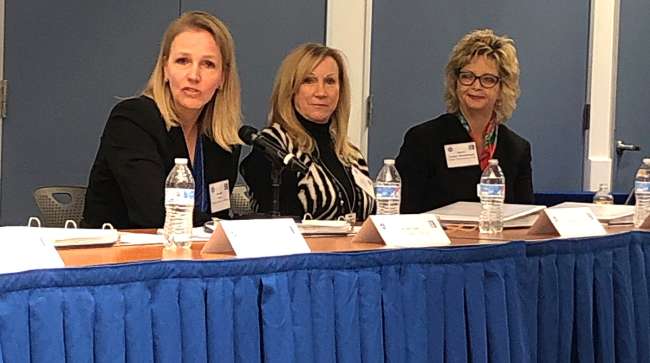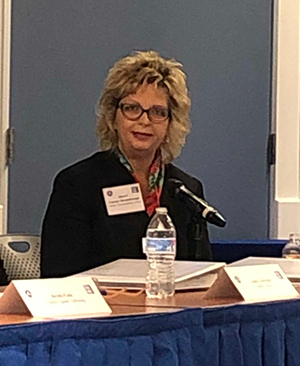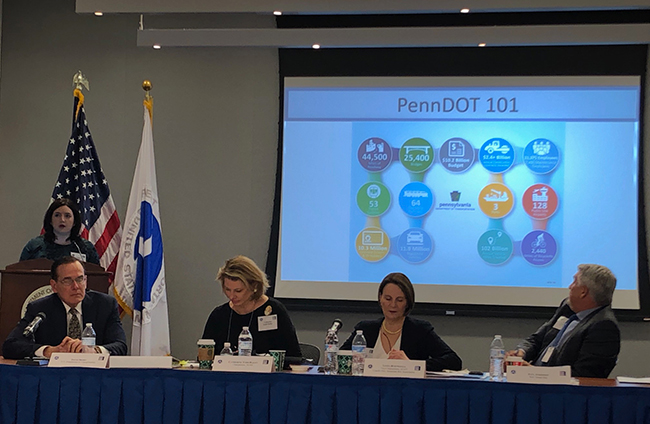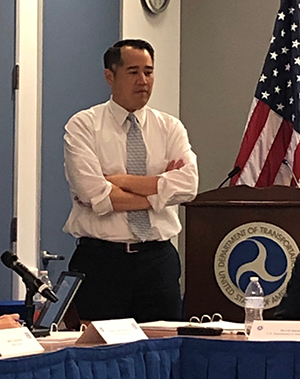Staff Reporter
DOT’s Committee Against Human Trafficking Holds First Meeting

WASHINGTON — Targeted outreach efforts and training are key to reaching industry representatives who can aid in the fight against human trafficking, according to Kendis Paris, executive director of Truckers Against Trafficking.
Paris is one member of the 15-person Advisory Committee on Human Trafficking, which was developed by the U.S. Department of Transportation in October. The group’s goal is to develop strategies for reporting human trafficking and craft recommendations for DOT-funded programs to combat the issue.
The committee includes leaders of organizations that fight modern slavery, academics and representatives of the trucking, bus, rail, aviation, maritime and port industries. It held its first public meeting Dec. 6.
Truckers Against Trafficking leads training programs and distributes education materials to various sectors of the industry, such as carriers, shippers, trucking associations, bus terminals and commercial driver license schools. Paris recommended creating materials that are specific to certain industry niches.
“We need to partner well”—@TATKylla ‘s Kendis Paris on need for collaboration to fight human trafficking @USDOT pic.twitter.com/gmnkhjIsQ6 — Eleanor Lamb (@eleanorannlamb) December 6, 2018
“You’ve got to train the industry. We speak the language of the market sector we’re going after,” Paris said. “We have been so impressed by the leadership, primarily at the trucking industry, when it comes to fighting human trafficking in transportation.”
Paris stressed the importance of partnering with law enforcement agencies at the state level. About 40 states have adopted aspects of Truckers Against Trafficking’s training model. The group has worked with law enforcement officers who give informational wallet cards to truck drivers.
The Iowa Department of Transportation’s motor vehicle enforcement chief, David Lorenzen, another committee member, said agency officers meet with members of the motor carrier industry daily. Many major interstates converge in Iowa, making the state an attractive hub for traffickers.
Paris pointed out that most professional truck drivers spend more time on the road than law enforcement officers and should therefore be attentive to suspicious activity at rest stops.
“These folks are trained to be vigilant and observant already as part of their everyday jobs,” Paris said. “Let’s not forget, they are moms and dads. Who better to rally, to be the eyes and ears out on the road?”

Garner Brumbaugh (Eleanor Lamb/Transport Topics)
American Trucking Associations Vice Chairman Sherri Garner Brumbaugh also serves on the committee. Garner Brumbaugh is president of Garner Trucking, which is based in Findlay, Ohio. She said all 135 of her drivers are trained with Truckers Against Trafficking’s courses.
“One single person can’t solve this problem, but, collectively, we can,” Garner Brumbaugh said.
One leading resource for victims and those who report incidents is the National Human Trafficking Hotline, which is operated by the nonprofit organization Polaris. The hotline receives about 250 calls a day, according to Associate Director Megan Cutter.
Cutter said that transportation is a vital part of human trafficking because victims often need to get from place to place. She identified long-distance buses and airplanes as the two most common vehicles traffickers use. She also said truckers call frequently to report activity seen at rest areas.
Emma Lowe, special assistant to Pennsylvania Department of Transportation Secretary Leslie Richards, stressed the importance of training state employees. PennDOT leads an initiative to combat human trafficking throughout the state, which includes 44,500 miles of roadway. Lowe said the National Human Trafficking Hotline received 562 calls from Pennsylvania-based people in 2017. Those calls confirmed 199 cases of human trafficking.

Lowe presents to the committee. (Eleanor Lamb/Transport Topics)
Lowe identified the employees who work at driver’s license centers as people who may encounter human trafficking efforts. She said that perpetrators often will withhold or manipulate identification documents. All employees at Pennsylvania’s 71 licensing centers have been trained on preventing human trafficking.
“They are the front line,” Lowe said. “They are the face of PennDOT.”
Looking to the future, Lowe said PennDOT will extend training to police staff, port employees and commercial driver license holders.
The Advisory Committee on Human Trafficking is broken into three subcommittees with distinct focuses: research and information sharing, training and public awareness, and protocols and policy development.

Kan (Eleanor Lamb/Transport Topics)
David Short, deputy assistant secretary of aviation and international affairs and designated federal officer for the committee, said that the group received more than 60 applicants, but DOT could only pick 15. The subcommittees will consist of many of the people who were not chosen to be full-time committee members.
The committee will have several more meetings, both in-person and over the phone, before submitting its recommendations to DOT by July 3.
“This is an important issue and a troubling issue, not only for the United States but also for the world. Almost every victim of human trafficking moves through a transportation hub,” Derek Kan, DOT’s undersecretary of transportation for policy, said during a brief appearance at the meeting. “We are grateful for all of your service. We are grateful for you taking time out for the many meetings we’re going to have. We look forward to your findings.”

